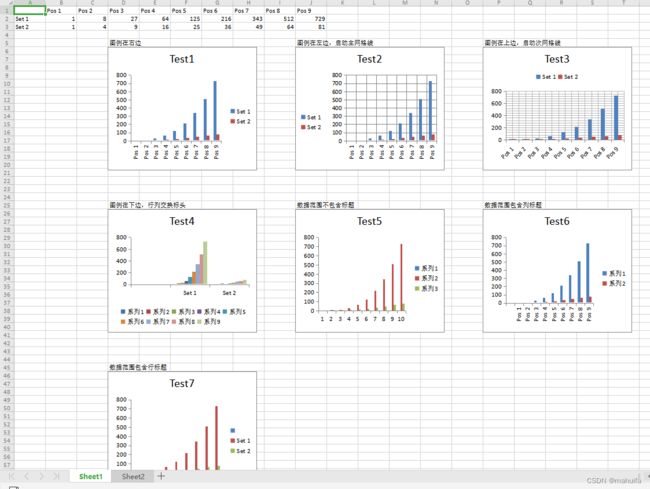Qt读写Excel--QXlsx插入图表5
Qt读写Excel–QXlsx插入图表5
文章目录
- Qt读写Excel--QXlsx插入图表5
-
- @[toc]
- 1、概述
- 2、准备工作
- 3、函数说明
- 4、示例代码
-
- 4.1 .h文件
- 4.2 .cpp文件
- 5、实现效果
- 6、源代码
文章目录
- Qt读写Excel--QXlsx插入图表5
-
- @[toc]
- 1、概述
- 2、准备工作
- 3、函数说明
- 4、示例代码
-
- 4.1 .h文件
- 4.2 .cpp文件
- 5、实现效果
- 6、源代码
| 更多精彩内容 |
|---|
| 个人内容分类汇总 |
1、概述
-
QXlsx是一个可以读写Excel文件的库。不依赖office以及wps组件,可以在Qt5支持的任何平台上使用;
-
使用方式
- QXlsx可以编译为动态库使用(使用动态库不用每次的编译,也可以让项目代码量更少,不用一打开工程就几十个文件);
- 直接将QXlsx.pri加入代码中使用(我比较推荐直接使用源码,因为QXlsx的注释信息基本在cpp文件中,可以通过阅读源码和注释来学习QXlsx的功能,当然,如果你已经熟悉了QXlsx的使用方式那编译成库使用会更方便,可以使工程的代码量变少);
-
本文中实现的功能:
- 插入所有类型的图表
- 插入面积图;
- 插入3D面积图(在WPS中显示存在问题,office没有测试);
- 插入折线图;
- 插入3D折线图;
- 插入雷达图(貌似还不支持);
- 插入散点图(在WPS中效果和CT_LineChart一样);
- 插入饼图;
- 插入3D饼图(这个图表在WPS中样式和CT_PieChart一样,没有表现出3D效果,无法设置三维旋转);
- 插入圆环图;
- 插入柱状图;
- 插入3D柱状图(在WPS中显示异常,不支持3D柱状图);
- 插入饼图(CT_OfPieChart还不支持);
- 插入曲面图(还不支持);
- 插入3D曲面图(还不支持);
- 插入气泡图(还不支持);
- 工作表插入图表【进阶】
- 设置【图例】位置;
- 设置图表【标题】;
- 打开图表网格线;
- 行列交换标头;
- 设置插入的数据范围是否包含标题;
- 插入图表,引用其它工作表数据。
- 添加一个图表Sheet,并插入柱状图。
- 插入所有类型的图表
2、准备工作
| Qt读写Excel–QXlsx基本使用1 |
|---|
| Qt读写Excel–QXlsx编译为静态库2 |
3、函数说明
注意:执行了操作要保存才生效。⛔
-
Chart *Document::insertChart(int row, int col, const QSize &size) - 功能说明: 在当前工作表第row行col列单元格【右下角位置】插入一个大小为size的图表;
- 参数row: 插入图表的左上角位于row行;
- 参数col: 插入图表的左上角位于col行;
- 参数size: 图表的大小;
- 返回值:返回指向刚插入的图表的指针;
-
void Chart::setChartType(ChartType type) - 功能说明: 设置图表的类型;
- 参数type: Chart::ChartType枚举定义的16种图表类型,其中部分类型还不支持;
-
void Chart::addSeries(const CellRange &range, AbstractSheet *sheet, bool headerH, bool headerV, bool swapHeaders) - 功能说明: 为图表添加用于显示的数据系列;
- 参数range: 添加数据的范围,例如:CellRange(“A1:C9”)表示添加第一列A1到C9的数据;
- 参数sheet: 添加的数据位于哪一个工作表,默认为当前工作表;
- 参数headerH: 数据系列范围第一行是否为列标题,true:为标题,默认为false;
- 参数headerV: 数据系列范围第1列是否为行标题,true:为标题,默认为false;
- 参数swapHeaders: true:交换行列标头;
-
void Chart::setChartLegend(Chart::ChartAxisPos legendPos, bool overlay) - 功能说明: 设置图表图例的位置;
- 参数legendPos: 图例位置,由Chart::ChartAxisPos枚举定义,可设置None:无图例, Left:左边, Right:右边, Top:上边, Bottom:下边;
- 参数overlay: 图例是否会被图表遮挡,true:被遮挡,默认为false。
-
void Chart::setChartTitle(QString strchartTitle) - 功能说明: 设置图表的标题;
- 参数strchartTitle: 需要设置的标题内容。
-
void Chart::setGridlinesEnable(bool majorGridlinesEnable, bool minorGridlinesEnable) - 功能说明: 是否开启图表的网格线;
- 参数majorGridlinesEnable: true:启动主网格线,默认为false;
- 参数minorGridlinesEnable: true:启动次网格线,默认为false;
4、示例代码
4.1 .h文件
/******************************************************************************
* @文件名 test4.h
* @功能 1、演示在工作表中插入所有QXlsx支持的图表类型和还不支持的类型,并通过WPS演示效果;
* 2、设置【图例】位置;
* 3、设置图表【标题】;
* 4、打开图表网格线;
* 5、行列交换标头;
* 6、设置插入的数据范围是否包含标题;
* 7、插入图表,引用其它工作表数据;
* 8、插入图表Sheet,并绘制一个柱状图
*
* @开发者 mhf
* @邮箱 [email protected]
* @时间 2022/06/26
* @备注
*****************************************************************************/
#ifndef TEST4_H
#define TEST4_H
#include 4.2 .cpp文件
#include "test4.h"
#include "ui_test4.h"
#include 5、实现效果
6、源代码
gitee
github


